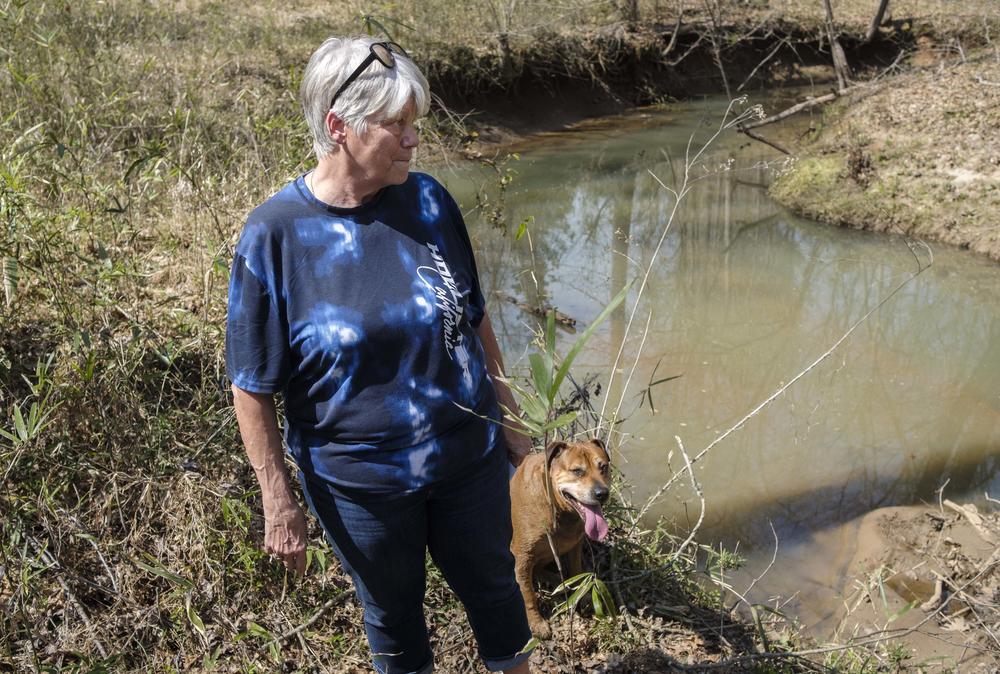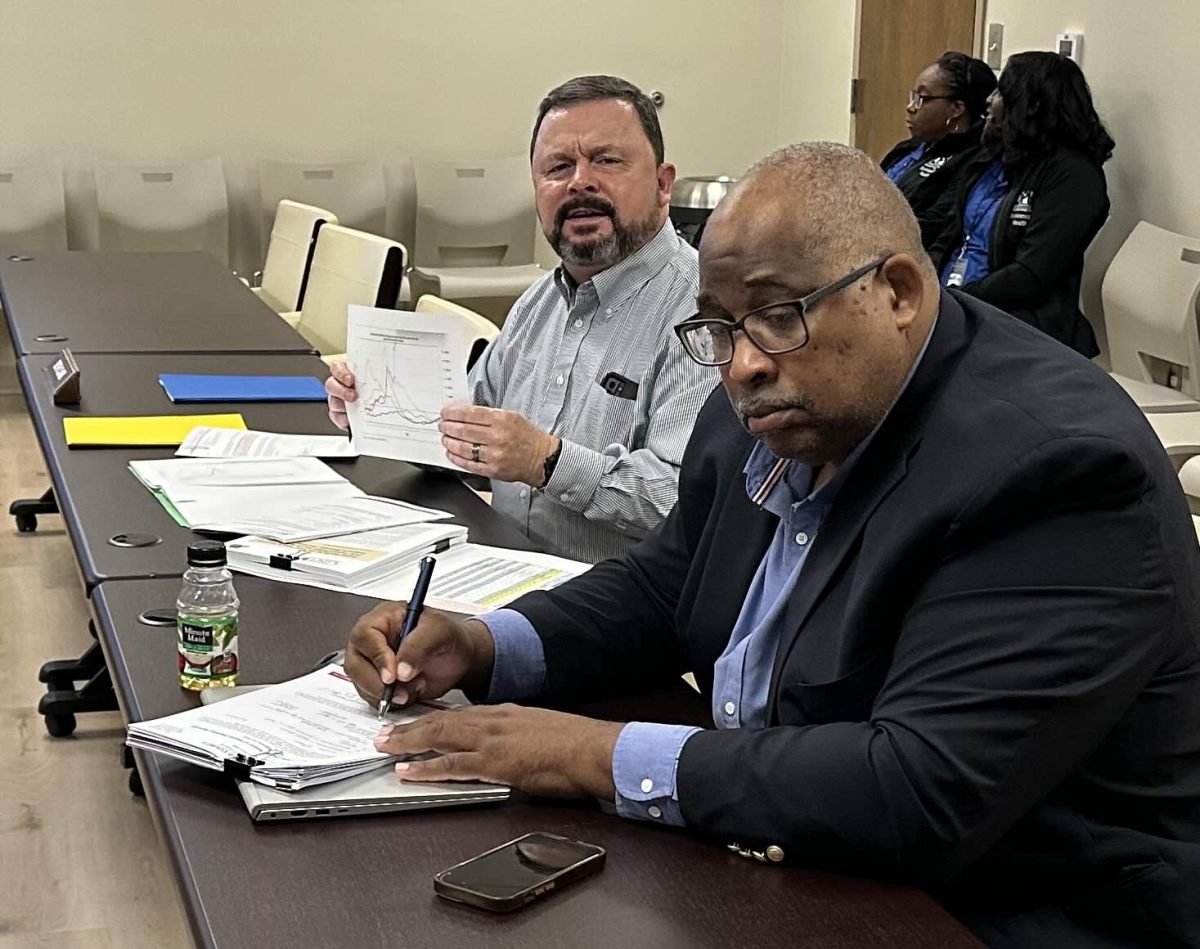Gloria Hammond’s house is the last one left on Luther Smith Road in Monroe County. Walk out the back of her house, through a patch of hardwoods and a canebrake and you come to Berry Creek.
“I walked down here the other day,” Gloria said recently, making the walk again with a reporter. “Just to go look. Nostalgia. You know, my husband’s birthday was yesterday.”
This makes five years now Gloria has marked her husband Cason’s birthday without him.
“It’s the same as it always is,” she said. “It’s just hard.”
Just uphill from Gloria’s house and on top of the headwaters of Berry Creek are 16 million tons of Georgia Power’s coal ash. Groundwater which, for decades, supplied the Hammonds and many of their neighbors with well water also flows through the ash leftover from generating electricity at Plant Scherer.
Gloria still wonders if what was once the water at her kitchen tap is connected to Cason’s death and the deaths of many of her neighbors.
“It’s hard to have proof,” she said. “You know, he had prostate cancer that just metastasized like that. Then he had another cancer, too.”
There are the throat and tongue cancers. The brothers who died from cancer a year apart. The liver cancer elsewhere in the family. The list of suspicions is long.
“Why not suspect?” Gloria asks.

The old homes on Luther Smith Road have long been replaced with Georgia Power monitoring wells stuck into the aquifer. Meanwhile, something residents of the Monroe County community of Juliette have said for years would help quell their suspicions would be if, when Georgia Power finally closes the Plant Scherer Ash Pond, they seal it off from groundwater. Forever.
That’s not the utility’s plan, nor is it the plan for many other coal ash ponds around the country, even though the federal Environmental Protection Agency is insistent it should be.
This spring, Georgia Power began the very first step in closing Scherer’s Ash Pond 1.
“The ash pond operated as a water treatment and solids management unit for years and years,” said Brett Mitchell, Georgia Power Director of Environmental Affairs.
Basically, since the 1980s, when the plant began burning coal to heat water into steam, which in turn spun dynamos to set electrons free, ash was pushed out the back of the plant and into the water (euphemistically called a ‘pond’) at what was, at one time, the largest single point source for carbon dioxide on the continent.
Once submerged in the water, the coal ash could no longer get airborne. Breathing it would have been a major health hazard.
“And then the 2015 federal rules came into play,” Mitchell said. “Which essentially required ponds to be closed.”
Even before then, Georgia Power was buying up homes, installing monitoring wells to track how heavy metals were traveling through groundwater and posting no trespassing signs on the now-cleared properties.
According to Georgia Power, the Scherer ash pond stopped receiving new ash in 2019. But the ash pond has still been receiving new water in the form of rain. Rain plus gravity can push the coal ash toxins out through the aquifer and to Berry Creek.
That’s why, when Ash Pond 1 is closed, it will have a roof.
“This plant is slated to have a synthetic cover,” said Mitchell. “That’s a HDPE plastic liner and then turf.”
All of that would be waterproof, stopping the rain from pressing down on the ash.
The further details of the plan, not yet approved by state regulators, are to shrink the footprint of the pond by about a third and to compact all 16 million tons of toxic material into one pile.
But wet ash is very heavy. To move it, the utility has to dry it out first. The process, now underway as of March, is called dewatering.
To dewater an ash pond, imagine a very large, complicated and expensive aquarium filter.
On the south side of the pond, near the looming plant itself, there’s a trailer full of special pumps that inject a chemical into the slurry that forces even the most microscopic bits of toxic material to clump up.
What happens next can actually be seen two stories up on a metal grated walkway through the rest of the rig where Georgia Power environmental specialist Jean Brown and others led a tour of the dewatering.
“And that was the intake pumps there. And, also you can see the final treatment, part of the treatment system over here…. The gravity filters over that way….,” Brown said.
And underfoot there was the water, brown and clouded, as if fouled by untold numbers of broken tea bags.
“So those, those particles, they, the flocculant, forms and settles out,” Brown said.
Eventually it gets filtered away. Then further down the grate, the water is clearer. After more filtering, the cleaned water will be pumped into the nearby Ocmulgee River.
Because the Scherer ash pond is so massive, just this step in closing the impoundment will take at least nine years.
Only then, says Georgia Power Director of Environmental Affairs Brett Mitchell, will come the big step of adding that plastic and turf raincoat to keep rain from infiltrating from above.
But there is no planned barrier preventing contact of water and the coal ash from below. Closure plans like this — waterproof up high and unsealed down low — are called, broadly, ‘cap-in-place’ closures.
So, Mitchell says, dewatered and closed might never mean dry.
“Some of the ash may very well still remain wet after closure,” he said.
And the ash may still flow through the aquifer and Berry Creek behind Gloria Hammond’s house. The company says it will track just how much for at least 30 years at those monitoring wells, many of which are piped into the lots where some of Gloria’s neighbors used to live.
Georgia Power Water Natural Resources Manager Scott Hendricks says this is because of the company’s definition of a key term: infiltration.
“When I think of infiltration, I’m thinking of rainwater that falls on top,” Hendricks said. “It infiltrates down.”
That’s the working definition, not only for Georgia Power, but for other electrical utilities across the country, too.
But that’s only part of the EPA definition.

A few years ago, the EPA resurrected a coal ash rule shelved during the Trump administration which says when it comes to coal ash and water, infiltration can come from any direction, including from underground. The rule has come into play in Ohio and Alabama, and now in Georgia.
At Plant Hammond near Rome, Georgia Power was given a cap in place permit like the one it wants at Plant Scherer. The pond there is closed, leaving about 10% of the Hammond coal ash in the aquifer there near the Coosa River.
But in a letter sent this February, the EPA told Georgia’s Environmental Protection Division that since the Hammond permit didn’t restrict the flow of groundwater in and out of the ash, it’s against the rules.
“The letter is a what I would call a politely worded smackdown of Georgia EPD’s misinterpretation of the closure standards for ash,” said Chris Bowers, senior attorney at the Southern Environmental Law Center.
What the EPA wants, broadly, is ash ponds waterproof all the way around, top and bottom.
Meanwhile, Georgia Power is currently voluntarily retrofitting a long ago capped-in-place but far smaller ash pond in just this way, 15 miles to the south at their Plant Arkwright in Macon, just upstream of the place where the local water utility draws from the Ocmulgee River.
Georgia EPD and Georgia Power are not the only entities interpreting the EPA’s rule on groundwater and coal ash. In March, attorneys representing the EPA and many utilities ( but not Georgia Power) argued the definition, again, of infiltration, before a three-judge panel of the U.S. Court of Appeals for the D.C. Circuit.
During the hearing, the judges sounded skeptical of the utility position that infiltration only comes from above. They also sounded concerned, but perhaps not to the same degree, by the fact that if the EPA rule stands it could mean untold extra billions of dollars to be spent by utilities on coal ash pond closure.
Whatever opinion issues from the D.C. court is likely to be appealed to the Supreme Court.
Meanwhile, people on both sides of the issue say even if the EPA’s no coal ash in groundwater rule is upheld by the Supreme Court, if he won a second term as president, Donald Trump would likely axe the rule altogether.














